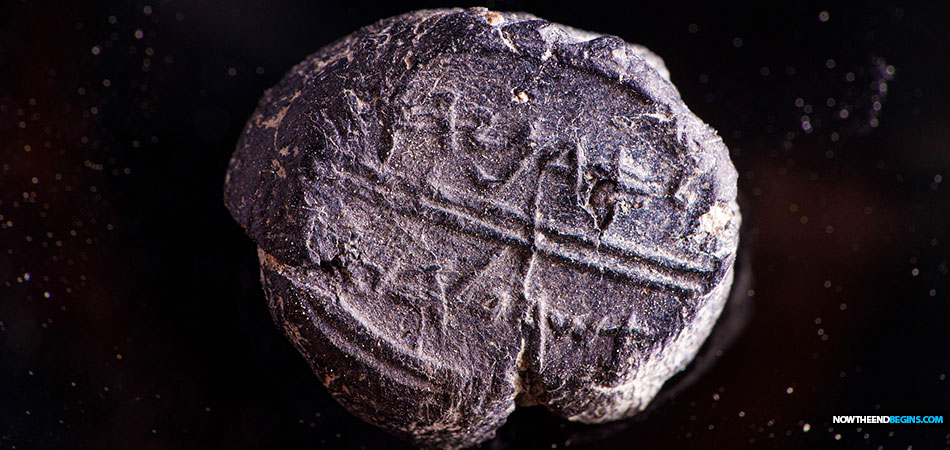
Inscribed with ‘Belonging to Adoniyahu, Royal Steward,’ a clay sealing from the 7th century BCE uncovered from earth excavated at the foundations of the Western Wall
The more the mythical Palestinians attempt to
assert historical ownership over Jerusalem, the more that God is allowing these amazing artifacts of biblical archaeology to come bubbling up to the surface. Visit our
section on biblical archaeology in Israel to see what I mean, these types of discoveries are definitely on the rise.
"Of the increase of his government and peace there shall be no end, upon the throne of David, and upon his kingdom, to order it, and to establish it with judgment and with justice from henceforth even for ever. The zeal of the LORD of hosts will perform this." Isaiah 9:7 (KJV)
Jerusalem, where the bulk of these discoveries come from, is called the in the Bible the 'city of David' as David was the greatest king God ever gave to Israel. So strongly is King David connected to Jerusalem that the Old Testament prophets tells us that when King Jesus
returns at the Second Coming with us on white horses, that He will rule and reign from the Throne of David. With that in mind, now perhaps you can see the
huge importance of finding this tiny, little seal from the First Temple era. God is talking, are you listening?
Inscribed with ‘Belonging to Adoniyahu, Royal Steward,’ a clay sealing from the 7th century BCE uncovered from earth excavated at the foundations of the Western Wall
FROM THE TIMES OF ISRAEL: A minuscule 7th century BCE clay sealing reading “Belonging to Adoniyahu, the Royal Steward,” was recently discovered in the City of David’s
sifting project. In earth excavated from the foundations of the Western Wall under Robinson’s Arch in 2013, a national service volunteer some three weeks ago unearthed the one-centimeter inscribed letter sealer bearing the ancient Hebrew name of a character found several times in the Hebrew Bible, Adoniyahu, literally, “The Lord is my Master.” (In English translations of the Bible, the name is written Adonijah.)
According to biblical archaeologist Eli Shukron, this inscription is unique and “of utmost importance.” The role of the Royal Steward (
Asher al Habayit), he said, appears several times in the Bible and is used for the highest-level minister in the royal court. For example, the title of Royal Steward was used in the Book of Genesis for Joseph’s high-powered position in Egypt. The clay sealing, or bulla, was used in the First Temple period to seal important documents, said Shukron.
In March, another rare bulla was published by the City of David bearing the inscription “(belonging) to Nathan-Melech, Servant of the King” (
LeNathan-Melech Eved HaMelech). Nathan-Melech is named in 2 Kings as an official in the court of King Josiah. And
in February 2018, another, partial clay sealing was discovered, which may spell out “Belonging to Isaiah,” (
l’Yesha’yah[u]) and is arguably tied to the Prophet Isaiah.
The new Adoniyahu inscription gives a potential link to a 150-year-old mystery: a First Temple, 7th century BCE rock cave grave, which is also inscribed with “Asher al Habayit.” The inscription, today found in the British Museum, has a partial name ending with the same three Hebrew letters as that of the new clay bulla.
Excavated in 1870 by the French archaeologist Charles Clermont-Ganneau, the grave’s inscription has been a subject of scholarly work ever since.
This grave was originally commonly thought to have been that of the most famous steward, Shevna (also found as Shevaniyahu), who is described in 2 Kings and in the Book of Isaiah as the Royal Steward of King Hezekiah of Judah. Tantalizingly, he was expelled from duty and is recorded as having carved a grave.
For years, scholars have attempted to tie the Kidron Valley grave to this biblical figure, despite the lack of a full identifier. The new inscription, Adoniyahu, also of the same period as the mysterious grave, may offer a new arena of research for linguists deciphering the burial inscription.
“Whether this [the royal steward Adoniyahu] is the person buried in the cave, we don’t know,” said Shukron. “When we’re speaking about the same time period, the First Temple period, 7th century BCE, the same geographical area, Jerusalem,” he shrugged, saying he could only end the thought with a question mark.
Holding the seal in his hand, Shukron said, “After 2,600 years, you come and hold this bulla, which was used to seal a letter, that was sent 2,600 years ago by the highest minister in the kingdom, it’s something amazing… It makes my heart skip a beat,” he added.
READ MORE
No comments:
Post a Comment